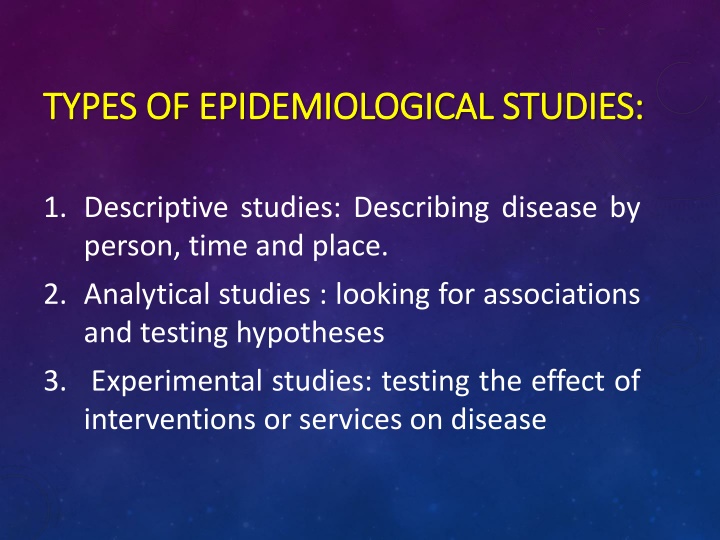
Understanding Different Types of Epidemiological Studies
Learn about the various types of epidemiological studies, including descriptive studies, analytical studies, and experimental studies. Explore the characteristics, benefits, and limitations of each type, such as cross-sectional studies, correlational studies, and case reports. Understand how these studies help in hypothesis formulation and finding associations in disease research.
Download Presentation

Please find below an Image/Link to download the presentation.
The content on the website is provided AS IS for your information and personal use only. It may not be sold, licensed, or shared on other websites without obtaining consent from the author. If you encounter any issues during the download, it is possible that the publisher has removed the file from their server.
You are allowed to download the files provided on this website for personal or commercial use, subject to the condition that they are used lawfully. All files are the property of their respective owners.
The content on the website is provided AS IS for your information and personal use only. It may not be sold, licensed, or shared on other websites without obtaining consent from the author.
E N D
Presentation Transcript
TYPES OF EPIDEMIOLOGICAL STUDIES: TYPES OF EPIDEMIOLOGICAL STUDIES: 1. Descriptive studies: Describing disease by person, time and place. 2. Analytical studies : looking for associations and testing hypotheses 3. Experimental studies: testing the effect of interventions or services on disease
DESCRIPTIVE STUDIES Descriptive provide Information on characteristics which will provide clue to epidemiological hypothesis. These studies concerned with; disease distribution according to person (population subgroups), area), and time (certain time) epidemiological studies Place (certain
Types 1.Cross-sectional studies 2.Correlational studies 3.Case report and case series
CROSS-SECTIONAL STUDIES (Characteristics)
2 2- -CORRELATIONAL STUDIES CORRELATIONAL STUDIES
2 2- -CORRELATIONAL STUDIES CORRELATIONAL STUDIES LIMITATION;
3-CASE REPORT AND CASE SERIES (Characteristics)
Methods of hypothesis formulation;
2-Analytic studies As you have seen, with descriptive studies we can characteristics of persons with disease, and we may question whether these features are really descriptive epidemiology answer that question. identify several unusual, but not does
2-Analytic studies Analytic epidemiology provides a way to find the answer. The comparison group or groups, which provide baseline data, are a key feature of analytic epidemiology. The investigator simply observes the natural course of events (noting if the persons exposed or not, and if they developed outcome or not).
Analytical (Observational) studies is of two basic types; Case control studies and cohort studies.
1-Case-control study Characteristics
Selection of cases; Sources include;
Selection of controls; Sources of controls;
Bias in case-control studies: Bias is any systematic error in the determination of the association between the exposure and the disease. Role of bias;
Types of cohort Cohort is divided into types depending on the temporal relationship between the initiation of the study and the occurrence of the disease. 1- Retrospectivecohort;
Retrospective & Prospective: Retrospective: looks backward from a disease to a possible cause. Prospective; looks forward from an exposure to an outcome. The feature that distinguishes a prospective from a retrospective cohort is simply and solely whether the outcome of interest has occurred at time of study initiation






















